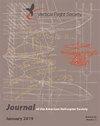叶尖涡流建模不确定性对直升机旋翼桨叶-涡流相互作用噪声预测的影响
IF 1.4
4区 工程技术
Q2 ENGINEERING, AEROSPACE
引用次数: 3
摘要
自由尾流模型通常用于直升机旋翼的气动声学分析;然而,他们的半经验主义伴随着与物理尾流参数建模相关的不确定性。在某些情况下,分析师不得不根据先前的实验证据对这些参数进行实证调整。本文研究了尾流气动建模中固有的不确定性对直升机旋翼气动声学分析鲁棒性的影响。采用自由尾流气动弹性转子模型预测高分辨率非定常载荷,包括叶片-涡流相互作用。转子气动声学模型基于Ffowcs-Williams–Hawkins方程的积分解,用于计算时域内的气动噪声。单独的分析模型被纳入不确定性分析的数值程序中,通过非侵入多项式混沌展开来实现。确定了尾流尖端涡核增长模型中潜在的不确定性来源,并系统地量化了它们对噪声预测的影响。当无法获得调整叶尖涡核模型的实验数据时,由叶片-涡流相互作用噪声主导的观测者的声压和噪声影响的不确定性分别可达25%和3.50 dB。导出了一组广义不确定性图,在缺乏校准半经验涡核模型所需的稳健证据的情况下,用作气动声学分析的建模指南。本文章由计算机程序翻译,如有差异,请以英文原文为准。
Impact of Tip-Vortex Modeling Uncertainty on Helicopter Rotor Blade–Vortex Interaction Noise Prediction
Free-wake models are routinely used in aeroacoustic analysis of helicopter rotors; however, their semiempiricism is accompanied with uncertainty related to the modeling of physical wake parameters. In some cases, analysts have to resort to empirical adaption of these parameters based
on previous experimental evidence. This paper investigates the impact of inherent uncertainty in wake aerodynamic modeling on the robustness of helicopter rotor aeroacoustic analysis. A free-wake aeroelastic rotor model is employed to predict high-resolution unsteady airloads, including blade–vortex
interactions. A rotor aeroacoustics model, based on integral solutions of the Ffowcs Williams–Hawkings equation, is utilized to calculate aerodynamic noise in the time domain. The individual analytical models are incorporated into an uncertainty analysis numerical procedure, implemented
through nonintrusive Polynomial Chaos expansion. The potential sources of uncertainty in wake tip-vortex core growth modeling are identified and their impact on noise predictions is systematically quantified. When experimental data to adjust the tip-vortex core model are not available the
uncertainty in acoustic pressure and noise impact at observers dominated by blade–vortex interaction noise can reach up to 25% and 3.50 dB, respectively. A set of generalized uncertainty maps is derived, for use as modeling guidelines for aeroacoustic analysis in the absence of the robust
evidence necessary for calibration of semiempirical vortex core models.
求助全文
通过发布文献求助,成功后即可免费获取论文全文。
去求助
来源期刊

Journal of the American Helicopter Society
工程技术-工程:宇航
CiteScore
4.10
自引率
33.30%
发文量
36
审稿时长
>12 weeks
期刊介绍:
The Journal of the American Helicopter Society is a peer-reviewed technical journal published quarterly (January, April, July and October) by AHS — The Vertical Flight Society. It is the world''s only scientific journal dedicated to vertical flight technology and is available in print and online.
The Journal publishes original technical papers dealing with theory and practice of vertical flight. The Journal seeks to foster the exchange of significant new ideas and information about helicopters and V/STOL aircraft. The scope of the Journal covers the full range of research, analysis, design, manufacturing, test, operations, and support. A constantly growing list of specialty areas is included within that scope. These range from the classical specialties like aerodynamic, dynamics and structures to more recent priorities such as acoustics, materials and signature reduction and to operational issues such as design criteria, safety and reliability. (Note: semi- and nontechnical articles of more general interest reporting current events or experiences should be sent to the VFS magazine
 求助内容:
求助内容: 应助结果提醒方式:
应助结果提醒方式:


